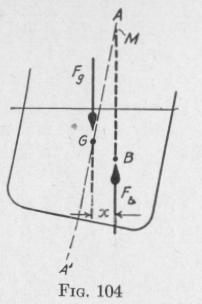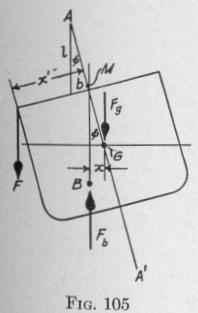132 ANTI-ROLL DEVICES FOR SHIPS
the ship at regular intervals, and the period of the oncoming waves is nearly equal to the period of roll of the ship, then the angular amplitude of roll quickly builds up to a considerable value. The building up of a large amplitude of oscillation by the cumulative effect of a periodic disturbance having nearly the same period as that of the vibrating body is called resonance (Art. 26). The large angle of roll, so common with ships at sea, occurs when the period of the oncoming waves is nearly equal to a natural period of oscillation of the ship. The period at which the oncoming waves meet the boat depends on how fast they travel, the distance from one
wave to the next, the course of the boat across the waves, and the speed of the boat.
83. The Pitching of a Ship Due to Waves. - If either the bow or the stern of a ship with a single propeller be suddenly raised or lowered, the precession thereby produced will deflect the ship's course either to the right or to the left. This " yawing " or " nosing " from side to side results in the pushing aside of a larger mass of water by the moving ship and a consequent loss of power and speed. Pitching increases the difficulty of maintaining the ship's course and increases the fuel consumption. The yawing produced by pitching can be neutralized by the use of two similar propellers and shafts rotating in opposite directions. This device, however, does not diminish the up-and-down pitching motion with the accompanying discomfort to passengers, danger of injury to freight, and strains within the frame of the ship, nor does it reduce the natural yaw due to a wave not striking the bow and stern at the same time.
84. The Metacentric Height. - When a vessel floats upright, the center of gravity G and the center of buoyancy B are on the same vertical central line AA', Fig. 104. When the vessel is heeled over, the center of buoyancy is displaced to one side of the
THE OSCILLATION OF A SHIP IN A SEAWAY 133
central line. So long as the heeling does not exceed about 10 degrees, the line of action of the buoyant force intersects the central line AA' near the same point M. That point in a floating body slightly dis
placed from equilibrium, through which the resultant upward force of the displaced liquid intersects the vertical through the center of buoyancy when the body is not displaced, is called the metacenter of the body. If a ship be slightly tilted from the equilibrium position, the intersection M, of the line of action of the force of buoyancy and the line perpendicular to the decks of the ship through the center of gravity, coincides with the metacenter of the ship. The metacenter for rolling does not coincide usually with the metacenter for pitching.
If the metacenter is above the center of grav
ity, the vessel is stable; if it is below the center of gravity, the vessel is unstable; if it coincides with the center of gravity, the vessel is statically neutral. The distance MG from the metacenter to the center of gravity is called the metacentric height of the vessel. The degree of stability of a vessel depends upon the metacentric height.
A vessel with a metacentric height that is large in comparison
with the size of the vessel has a large righting moment, a short
period of roll, is very stable, but will
roll quickly through large angles and will change its direction of roll with a jerk.
Such a vessel is difficult to steer, requires
an excessive amount of fuel for a given
speed, and is uncomfortable for crew and
passengers. Many cargo steamers carry
ing coal or ore are uncomfortable and hard
to handle because of their great metacen
tric height. If this cargo could be dis
tributed so as to raise the center of gravity
of the vessel the severity of these troubles
would be diminished.
8b. The Experimental Determination of the Metacentric Height. - The metacentric height of a vessel of known tonnage displacement can be determined from an observation of the tilting produced by shifting a known weight of crew or ballast for a known distance across the deck. In Fig. 105, a


